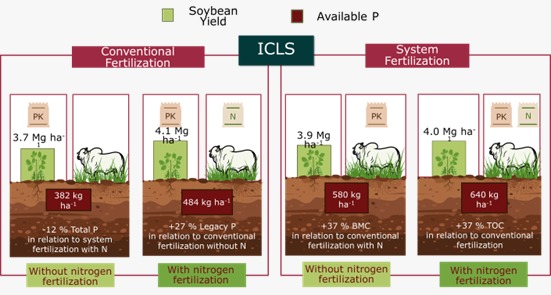Rev. Bras. Ciênc. Solo.2025;49(spe1):e0240164.
Fertilization strategies to improve phosphorus availability and soil quality in integrated crop-livestock system in tropical soils
13/Oct/2025
DOI: 10.36783/18069657rbcs20240164
Graphical Abstract

Highlights
The results suggest that soil P fractions are influenced by fertilization strategies.
Addition of nitrogen in the pasture phase increases P availability.
System fertilization with nitrogen increased soybean yields and levels of TOC.
Conventional fertilization resulted in the lowest values for the evaluated P fractions.
ABSTRACT
Exploring different fertilization strategies in an integrated crop-livestock system (ICLS) can enhance soil phosphorus (P) availability and improve soil quality, ultimately leading to higher yield. This study aimed to evaluate different fertilization strategies in ICLS and their effects on soil P fractions, soil quality and soybean grain yield in a tropical soil. Initiated in 2019, the experiment tested four fertilization strategies: 1) Conventional fertilization with P and K applied at soybean sowing (CF); 2) CF + N fertilization in the pasture phase (CF+N); 3) System fertilization with P and K applied in the pasture phase (SF) and; 4) SF + N fertilization in the pasture phase (SF+N). Nitrogen fertilization in the pasture (CF+N and SF+N) increased soil P availability by up to 32 %. Additionally, SF+N increased the contents of total and inorganic P extracted with NaOH and HCl by up to 12, 49 and 59 %, respectively, compared with CF. A similar trend was observed for the P legacy index, where SF was approximately 4.1 times higher than the CF. The metabolic quotient was also enhanced, and microbial biomass carbon (BMC) was increased in system fertilization treatments. However, soil physical properties, such as weighted mean diameter and geometric mean diameter, remained unaffected by the fertilization strategies. Soybean grain yield was 16 % higher in the treatment with SF+N, compared with CF, indicating that both the P and K fertilization strategies and the presence of N in the pasture can alter soybean yield. Soybean crop benefits from the enrichment of N in the soil via fertilization in the pasture phase, and, when combined with system fertilization, the benefits are enhanced by the greater availability of P, total P, and the index of legacy P in the soil.
179

